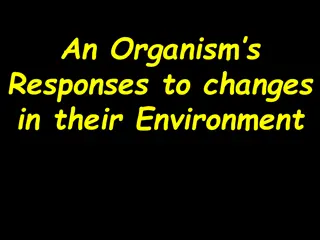Responses to External Environmental Alterations
Environmental factors like temperature, altitude, nutrition, stress, and more can impact thyroid function and metabolism, leading to changes in hormone levels and physiological responses. This includes effects of cold exposure, heat, high altitude, anoxia, alterations in light, nutrition deficiencies, and stress. These alterations influence hormone secretion, metabolism pathways, and physiological adaptations.
Download Presentation

Please find below an Image/Link to download the presentation.
The content on the website is provided AS IS for your information and personal use only. It may not be sold, licensed, or shared on other websites without obtaining consent from the author.If you encounter any issues during the download, it is possible that the publisher has removed the file from their server.
You are allowed to download the files provided on this website for personal or commercial use, subject to the condition that they are used lawfully. All files are the property of their respective owners.
The content on the website is provided AS IS for your information and personal use only. It may not be sold, licensed, or shared on other websites without obtaining consent from the author.
E N D
Presentation Transcript
Response to alteration in the external environmental Environmental Temperature Effect of cold Effect of heat High altitude & anoxia Alteration in light Nutrition Starvation & fasting Protein calorie malnutrition (PCM) Overfeeding & obesity 10) Minerals 11) Physical & emotional stress 12) Surgery 13) Acute mental stress 1) 2) 3) 4) 5) 6) 7) 8) 9)
Response to alteration in the external environmental 1) Environmental Temperature Changes in T may causes alteration in TSH secretion & in serum conc Of thyroid hormones and their metabolism The changes mediated through hypothalamus & pituitary and peripheral effects on pathways and rates of thyroid h degradation and losses & alteration in h secretion
Response to alteration in the external environmental 2) Effect of cold Increased TSH in serum observed in infants & young children during surgical hypotheremia Cold exposure in animal lead to thyroid hyperplasia, enhanced h secretion, degradation & excretion, accompanied by increase demand for dietary iodine
Response to alteration in the external environmental 3) Effect of heat Increase in T produce effects opposite to those observed in cold exposure Thyroid h level in serum be lower during summer months. Decrease in serum T3 conc With reciprocal changes in levels of rT3 observed in normal acutely exposed to heat & during febrile illness. Decrease in elevated serum TSH associated with primary hypothyroidism induced by increase body T
Response to alteration in the external environmental 4) High altitude & anoxia Increase the rate of T4 degradation. At very high elevations(5400-6300 m) elevate T4, Ft4, T3 & TSH with Ft3. When compared to those residing at sea level, individuals adapted to altitude were to be lower T4 with higher fT4 and T3 levels & normal TSH response to TRH. Thyroidal iodinative activity and T4 formation are diminished.
Response to alteration in the external environmental 5) Alteration in light Pinealectomy induces moderate in thyroid weight and continuous light exposure T4 secretion rate about 20% In squirrels, continuous darkness produces thyroid weight & T4 levels, But this effect is blocked by Pinealectomy . Melatonin has inhibitory effect on thyroid gland function.
Response to alteration in the external environmental 6) Nutrition Thyroid hormone play central role in regulation of total body metabolism, nutritional factors may alter the regulation, supply this thermogenic hormone The most important effects of dietary changes related to alteration in total caloric intake and supply of iodine The changes associated with caloric deprivation appear homeostatic in nature are reduction in catabolic Changes observed with deficiency or excess iodine of thyroid h, principally through modification in thyroidal iodide accumulation & binding
Response to alteration in the external environmental 7) Starvation & fasting Serum TT3 within 24-48 h of initiation of fasting is decreased They attributed to conc of carrier proteins in serum caused by inhibitory effect of free fatty acids which during fasting. A in plasma T3 after fasting with in hepatic type III deiodinase activity observed in chicken. Reduction in maximal binding capacity has been demonstrated to coincide with reduction in thyroid h receptors Affinity of h at liver T3 receptors is not affected by starvation
Response to alteration in the external environmental 8) Protein calorie malnutrition (PCM) PCM associated with lower serum T3 conc and rT3 level due to similar changes in iodothyronine monodeiodination. Experimental model of protein malnutrition in the rat yielding different results from observed in human Serum T4 & T3 levels found in both elevated. In the lamb, as in human chronic malnutrition leads to lower rate of T4 utilization.
Response to alteration in the external environmental 9) Overfeeding & obesity Overfeeding produces in serum T3 conc as a result of conversion of T4 to T3, it marked when excess caloric are given in the form carbohydrates. The effect of overnutrition on iodothyronine metabolism is the opposite of starvation
Response to alteration in the external environmental 10) Minerals Iodine of many minerals affect thyroid function. it is essential substance for thyroid h synthesis and also interacts with the function of thyroid gland at several levels. 1. Ca 2. Nitrate 3. Bromine 4. Rubidium 5. Fluorine 6. Cobalt 7. Cadmium 8. Lithium ion 9. Selenium
Response to alteration in the external environmental // minerals 1. Calcium Ca is goitrogenic when in diet excess Administration of 2g Ca 1 day was associated with iodide clearance by thyroid. It in some way make overtabore- erline diatery iodine deficiency Ca also acutely & chronically thyroxine absorption
Response to alteration in the external environmental // minerals 2. Nitrate It in diet (0.3-0.9%) can interfere with I uptake in the thyroid of rats & sheep, this conc is found in some types of hay & silage 3. Bromine It is concentrated by thyroid and interfere with thyroid I uptake in animals & human, possibly competitive inhibition of iodide transport to the gland It also can induce alterations in cellular architecture, blood supply and reduce T4 & T3 levels
Response to alteration in the external environmental // minerals 4. Rubidium It is giotrogenic in rats. 5. Fluorine It is not concentrated by thyroid but has mild antithyroid effect possibly by inhibiting the iodide transport process. In large amount, it giotrogenic in animals
Response to alteration in the external environmental // minerals 6. Cobalt It inhibits iodide binding by thyroid. Cobalt deficiency associated with reduction in type I monodiiodinase activity and fall in T3 while Cobalt excess may produce goiter and decreased thyroid h production. It is sufficiently active in treatment of thyroxosis. 7. Cadmium Administration of Cadmium of rats decreases serum levels of T4 & T3. It also decreases activity of hepatic type I monodiiodinase
Response to alteration in the external environmental // minerals 8. Lithium ion It is goitrogenic when used in treatment manic depressive psychosis and induce myxedema. Experimentally it thyroid weight and slow thyroid iodine release when Lithium carbonate given to human subjects in doses of 900mg 4 times daily There is significantly decrease in rate of thyroid iodine release in urthyroid and hyperthyroid subject
Response to alteration in the external environmental // minerals 9. Selenium It is component of enzyme gluthion peroxide (GSH-PX) & superoxide dimutase, both enzymes responsible for protection against free radicals. Type I 5-Deiodinaes also contains Selenium. Deficiency of Selenium can cause thyroid toxidative injury and lead to decreased peripheral T3 production
Response to alteration in the external environmental 11) Physical & emotional stress Found that stress provoked thyrotoxicosis in wild rabbits Some models may prompt secretion of thyroid h in animals This effect unlikely to occur in human, at lead for sustained period to time The stress- induced increase in adrenocorticol activity tends not onto suppress TSH release but also to inhibit production 12) Surgery It has been used as a means to study the effect of stress on thyroid physiology in animals.
Response to alteration in the external environmental 13) Acute mental stress The effect of emotional stress on thyroid function. Acute psychiatric decomposition are considered, the results are colored by the nature of the mental illness, its antecedent history, and the use of drugs. Enhanced h secretion came from the observation of elevated protein-bound iodine (PBI) levels in serum of psychiatric patients presumably under emotional stress Elevation of the FT4 l have been consistently found during admission of acute psychiatric patients the TSH response to TRH is blunted or even absen .























